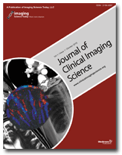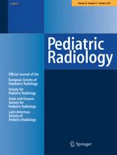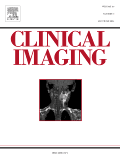
Applied Radiology
Scope & Guideline
Pioneering Advances in Imaging for Better Patient Care
Introduction
Aims and Scopes
- Clinical Applications of Imaging Techniques:
The journal emphasizes the practical use of various imaging modalities such as MRI, CT, and ultrasound in diagnosing and managing a wide range of medical conditions. - Advancements in Artificial Intelligence and Imaging:
There is a strong focus on how AI is transforming radiology, including discussions on algorithm bias, regulatory environments, and the integration of AI into clinical workflows. - Global Health and Equity in Radiology:
Applied Radiology addresses disparities in healthcare access and imaging services, highlighting initiatives aimed at improving global health outcomes. - Workflow Optimization and Productivity in Radiology:
The journal explores methods to enhance efficiency in radiology departments, including workflow strategies and technology adoption. - Education and Training in Radiology:
There is a consistent emphasis on the importance of training and education for radiologists, including discussions on fellowship match processes and ongoing professional development.
Trending and Emerging
- Integration of Artificial Intelligence in Clinical Practice:
There is a growing trend towards exploring how AI can enhance diagnostic accuracy, improve workflow efficiency, and aid in decision-making processes for radiologists. - Focus on Global Health Initiatives:
Recent articles emphasize the role of radiology in addressing global health challenges, including access to imaging services in underserved populations and the impact of healthcare disparities. - Sustainability and Environmental Considerations in Radiology:
Emerging discussions around sustainability reflect a shift towards environmentally conscious practices within radiology, including waste reduction and the responsible use of resources. - Telemedicine and Remote Imaging Solutions:
The rise of telehealth and remote imaging capabilities has been increasingly addressed, particularly in the context of expanding access to care during the COVID-19 pandemic. - Personalized Medicine and Imaging Biomarkers:
There is an increasing focus on the role of imaging in personalized medicine, particularly in cancer care, where imaging biomarkers are being explored for tailored treatment approaches.
Declining or Waning
- Traditional Imaging Modalities:
There has been a noticeable decline in articles solely focused on traditional imaging techniques without integration of newer technologies or AI, indicating a move towards more innovative approaches. - Generalized Reviews without Specific Focus:
Articles that provide broad overviews of radiology without addressing specific advancements or clinical applications have become less prevalent, reflecting a shift towards more targeted and impactful research. - Historical Perspectives on Radiology:
While the journal has published historical accounts and reflections on the evolution of radiology, there seems to be a waning interest in these retrospective pieces as the focus shifts to current and future trends.
Similar Journals

SKELETAL RADIOLOGY
Exploring Innovations in Musculoskeletal RadiologySkeletal Radiology, published by Springer, is a preeminent journal dedicated to the field of radiology, specifically focusing on the anatomical and pathological aspects of the skeletal system. Covering a breadth of topics from imaging techniques to innovative diagnostic methodologies, it aims to enhance knowledge and expertise in the interpretation of musculoskeletal conditions. Operating under the ISSN 0364-2348 and E-ISSN 1432-2161, the journal has established itself as a key resource for researchers, clinicians, and medical professionals, boasting an impressive impact factor that reflects its scholarly significance. As of 2023, it holds a commendable ranking in the Q2 quartile for Radiology, Nuclear Medicine and Imaging, and ranks #123 out of 333 in the Scopus database, placing it in the 63rd percentile. With a history spanning from 1976 to 2024, this journal continually seeks to publish high-quality research that advances the understanding of skeletal radiology. While it does not currently offer Open Access options, its rigorous peer-review process ensures that only the most relevant and impactful studies are shared with the global academic community.

Journal of Clinical Imaging Science
Elevating Standards in Imaging Science and PracticeWelcome to the Journal of Clinical Imaging Science, a dedicated platform for disseminating pioneering research in the field of radiology, nuclear medicine, and imaging. Published by SCIENTIFIC SCHOLAR LLC, this peer-reviewed journal offers a prominent forum for researchers, professionals, and students to share insights and advancements that push the boundaries of clinical imaging practice and technology. With a proud history of publication since 2011 and converged years extending through 2024, the journal currently ranks in the top quartile (Q3) as per the 2023 categorization in the relevant field, positioning itself as a valuable resource among its peers. While embracing a non-open access model, it guarantees high-quality content that contributes to the 36th percentile of Scopus rankings for medicine and imaging sciences. The Journal of Clinical Imaging Science aspires to enhance the knowledge base in clinical settings and promote innovative methodologies, serving as an essential tool for advancing education and practice in imaging sciences.

PEDIATRIC RADIOLOGY
Enhancing diagnosis and treatment in pediatric medicine.Pediatric Radiology is a leading journal published by Springer that provides a crucial platform for the dissemination of research in the fields of pediatrics, perinatology, and radiology. Since its inception in 1973, the journal has continually contributed to the advancement of medical imaging techniques and their application in diagnosing and treating pediatric conditions. With its impact factor reflecting a Q2 ranking in both Pediatrics and Radiology categories as of 2023, Pediatric Radiology is highly regarded in scholarly circles, aiding researchers, clinicians, and students to stay at the forefront of innovations and findings in the field. Although the journal does not offer open access, it continues to be an essential resource for evidence-based information that enhances clinical practice and improves health outcomes for children globally. The journal's reach is further established through its solid Scopus rankings, indicating its relevance and influence in the global medical community.

Emergency Radiology
Innovating Emergency Diagnostics for Better Patient OutcomesEmergency Radiology, published by SPRINGER HEIDELBERG, is a leading journal in the fields of emergency medicine and radiology, dedicated to advancing the understanding and application of diagnostic imaging in urgent medical conditions. Established in 1994, this journal has consistently contributed to the discourse around emergency diagnostics, maintaining a strong position within the academic community, as evidenced by its Q2 rankings in both Emergency Medicine and Radiology, Nuclear Medicine and Imaging categories as of 2023. With a distinguished focus on innovative research and case studies, it serves a diverse audience of researchers, clinicians, and healthcare professionals who seek to enhance their knowledge and improve patient outcomes in emergency settings. While the journal is not currently open access, it offers robust subscription options and continues to be an integral resource for those at the forefront of emergency care. With an ISSN of 1070-3004 and an E-ISSN of 1438-1435, Emergency Radiology is positioned to remain a key player in shaping the future of medical imaging through its commitment to high-quality research and evidence-based practices.

Clinical Imaging
Exploring New Frontiers in Clinical ImagingClinical Imaging, published by Elsevier Science Inc, is a renowned journal dedicated to the field of radiology, nuclear medicine, and imaging. With an ISSN of 0899-7071 and an E-ISSN of 1873-4499, this esteemed publication has established its significance in advancing imaging science since its inception in 1989 and continues to make impactful contributions to the discipline through 2024. The journal holds a prestigious Q2 ranking in the category of Radiology, Nuclear Medicine, and Imaging, reflecting its critical role in bridging research and clinical practice. Currently ranked #113 out of 333 by Scopus, with a notable 66th percentile, it offers a platform for disseminating high-quality research, reviews, and case studies that inspire innovation and enhance imaging techniques. Although it primarily functions as a subscription-based journal, it remains dedicated to accessibility and the dissemination of pivotal findings that inform both academia and clinical settings. Clinical Imaging is essential for researchers, professionals, and students alike, offering insights that shape the future of diagnostic imaging.

Journal of the Belgian Society of Radiology
Empowering Radiologists with Open Access InsightsThe Journal of the Belgian Society of Radiology, published by UBIQUITY PRESS LTD, is a pivotal resource in the field of radiology, nuclear medicine, and imaging. With an ISSN of 2514-8281 and E-ISSN of 2514-8281, this open access journal has been dedicated to fostering the dissemination of high-quality research since its establishment in 2010. Distributed from the United Kingdom, it offers a platform for innovative studies, case reports, and reviews that contribute to the advancement of radiological sciences. Despite its current Q4 category ranking within Scopus, the journal plays a critical role in sharing essential findings with a community of over 1,200 professionals and students eager to stay abreast of emerging trends and technological advancements in imaging. By enabling unrestricted access to its publications, the journal encourages collaborative research and knowledge exchange that transcends geographic boundaries, solidifying its importance for both established researchers and emerging scholars in the discipline.

ROFO-FORTSCHRITTE AUF DEM GEBIET DER RONTGENSTRAHLEN UND DER BILDGEBENDEN VERFAHREN
Pioneering Insights for Modern Diagnostic PracticesROFO-Fortschritte auf dem Gebiet der Röntgenstrahlen und der bildgebenden Verfahren, published by Georg Thieme Verlag KG, is a pivotal journal in the fields of radiology and nuclear medicine, offering invaluable insights for researchers, healthcare professionals, and students alike. With an ISSN of 1438-9029, this journal has been a stalwart of scientific communication since its inception in 1975, actively contributing to advancements in imaging techniques and radiation therapy. Although it operates under traditional access, the journal maintains a respectable standing, reflected by its Q3 ranking in Radiology, Nuclear Medicine and Imaging and Q4 in Medicine (miscellaneous), highlighting its significance in the scholarly community. Its coverage spans a wide array of topics pertinent to diagnostic imaging and therapy protocols, making it an essential resource for anyone seeking to understand the complexities of modern radiological practices. As the journal continues to evolve through 2024, it invites contributions that enrich the dialogue around technological innovations and clinical applications in the realm of imaging modalities.

Imaging
Exploring the Future of Radiology and UltrasoundImaging, published by AKADEMIAI KIADO ZRT, is an esteemed open-access journal dedicated to the field of medical imaging, established in 2020. With an E-ISSN of 2732-0960 and based in Budapest, Hungary, this journal provides a vital platform for the dissemination of cutting-edge research and advancements in imaging techniques, especially in the realms of radiology, nuclear medicine, and ultrasound technology. While currently positioned in the Q4 category across multiple medical specialties, the journal continues to strive for improvements in visibility and impact, contributing to the evolving discourse in medical imaging. The journal aims to facilitate an inclusive and collaborative environment for researchers, professionals, and students, inviting them to share their findings and insights to enhance the field's development. With open-access availability since its inception, Imaging ensures free and easy access to its content, fostering a greater understanding and appreciation of innovative imaging practices worldwide.

SA Journal of Radiology
Transforming Practice: Elevating Radiology Through Open AccessThe SA Journal of Radiology is a prominent open-access journal published by AOSIS, dedicated to advancing knowledge in the fields of Radiology and Ultrasound Technology. Established in 2004, this South African journal provides a platform for researchers, professionals, and students to disseminate valuable findings and share innovative practices in medical imaging. With an ISSN of 1027-202X and an E-ISSN of 2078-6778, the journal has become an important resource for those involved in radiological sciences, despite currently holding a Q4 ranking in both Radiological and Ultrasound Technology and Radiology, Nuclear Medicine and Imaging categories. Covering a converged time span from 2014 to 2024, the journal aims to promote scholarly communication and enhance the accessibility of research, positioning itself as a key player in the global radiological community. In a landscape where open access is increasingly critical, the SA Journal of Radiology is committed to fostering research collaboration and facilitating the exchange of ideas among clinicians and academics alike.

RADIOLOGIC CLINICS OF NORTH AMERICA
Shaping the Future of Radiology Through Insightful Research.Radiologic Clinics of North America, published by W B Saunders Co-Elsevier Inc, stands as a pivotal resource in the field of medical imaging and radiology. With a solid history dating back to 1963 and converging years extending to 2024, this journal has established itself as a reputable platform for original research, comprehensive reviews, and insightful discussions that advance the knowledge and practice of radiology, nuclear medicine, and imaging. Holding a Q2 classification in both the miscellaneous medicine and radiology categories and positioned within the 56th percentile among its peers, its contributions are vital for both academic research and clinical applications. Although it does not offer open access, the journal remains accessible through institutional subscriptions and is a must-read for researchers, healthcare professionals, and students keen on the latest developments in radiological practices. With a dedicated editorial board and a commitment to the highest academic standards, Radiologic Clinics of North America continues to shape the future of the medical imaging field.